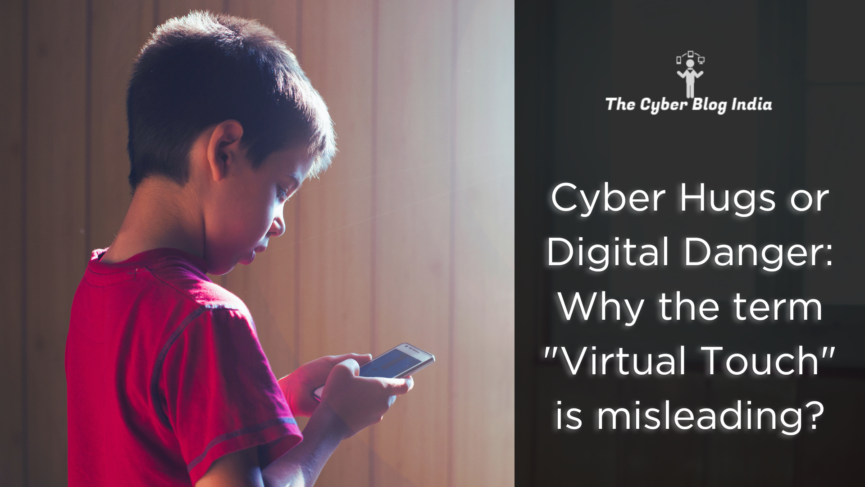Cyber Hugs or Digital Danger: Why the term “Virtual Touch” is misleading?

The feeling you get when your mom hugs you or when you see a parent kiss their toddler is the essence of good touch. But when something makes you uncomfortable or insecure in your own skin, that feeling is the true essence of a bad touch. According to the NCRB data from 2020, approximately 28.9% of the entire child population experienced some form of sexual crime. However, an India Today report claimed that only 65.6% of such cases were reported. Most children do not understand the difference between “good touch” and “bad touch.” As a result, children are particularly vulnerable to sexual abuse at the hands of their own close relatives. The most aggravating part of this is how perpetrators manipulate children into keeping the incident a “secret” because they do not know any better.
This is precisely why understanding the distinction between good touch and bad touch becomes fatal for every child’s social and psychological growth. However, the problem with this social awareness does not end here. A new form of child sexual abuse has come into our cyber space, aptly called “virtual touch.”
Virtual Touch
While rejecting a bail application in May 2024, the Delhi HC introduced the concept of virtual touch. The accused had approached the court seeking bail in a case involving allegations of drugging, kidnapping, and sexually exploiting a minor. The court noted that the youngster initially interacted with the accused on social media. It was recommended that minors be provided with the necessary knowledge and tools to manage their online interactions and identify any threats that may exist in cyberspace.
According to this order, virtual touch refers to criminals using cyberspace to target innocent, unsuspecting targets for their nefarious activities and purposes.
Virtual Touch or Virtual Bad Touch
There is no rigid definition for virtual touch because I believe the term itself seems misleading. It is misleading because any definition of virtual touch online would lead you to understand touch through cyberspace. This is possible through virtual reality (VR) or devices used to feel touch from across continents. The concept suggests a form of touch experienced through cyberspace, potentially involving VR or devices simulating physical touch. This broad and somewhat abstract idea is difficult to grasp, making it challenging to convey the necessary caution they should exercise in online interactions.
I would suggest simplifying it for the children and calling it virtual bad touch. First, you make them understand the concept of bad touch. Thereafter, you instil a sense of realisation that people could take advantage of them through the internet. This would cover the entire spectrum of internet scams that would entice a child and make them feel uncomfortable. By using this term, we immediately anchor the discussion in a framework that children are likely more familiar with. The concept of good touch-bad touch is a prominent part of many child safety programmes. This helps them understand that just as people in the real world can engage in inappropriate or harmful touch, similar dangers can exist online, albeit in different forms.
To Spread Awareness
Educating children about virtual bad touch involves helping them recognise that individuals on the internet can take advantage of them in ways that make them uncomfortable or unsafe. This could encompass a range of activities, such as inappropriate messages, solicitations for personal information, or coercive interactions through social media, gaming platforms, or other online spaces. Children can easily grasp the seriousness of these interactions by using a term that combines the familiar (bad touch) with the context (virtual).
In practical terms, this approach requires clear guidelines and communication. Parents and educators should discuss the types of online behaviour that constitute virtual bad touch. They should emphasise that just as kids report uncomfortable physical interactions, they should also report any online interaction that makes them feel uneasy. The stakeholders can encourage children to speak up without fear of punishment or judgment. This is crucial in fostering a safe environment where children feel empowered to share their concerns.
Moreover, incorporating lessons on digital literacy and internet safety into the curriculum can further protect children. Teaching them to recognise red flags equips them with the tools to navigate the internet more safely. However, as most educational institutions do, this becomes an annual activity where they call an expert to deliver a two-hour workshop. I believe it is about time the conversation on this issue moved beyond this annual thing and started happening continuously in educational institutions nationwide.
Conclusion
Reframing the concept of virtual touch to virtual bad touch provides a more tangible and comprehensible way for children to understand and navigate the potential dangers of the internet. We can better prepare them to recognise and respond to inappropriate or harmful online interactions by linking this idea to familiar safety concepts. We should ensure that our children remain safe in physical and virtual environments. Which of these two is the most sensible on this spectrum of terminologies?
